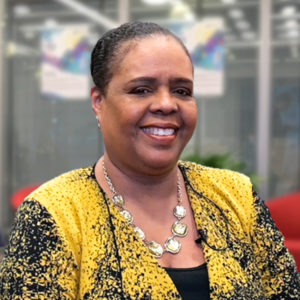A synopsis of the panel discussion about assessing success and serving students of color in the university admissions process hosted by the IB Senior Development Manager, Marie Vivas and featuring panelists from the University of Maryland, Princeton University, Rice University and Baltimore City College.
“It’s really important for us to understand that all students don’t have the same opportunities. All students don’t have the same struggles and challenges that they have to navigate and as a result of that, all students can’t be evaluated on the same surface”
So, to start: Should we treat students of color differently in the admissions process?
Shannon: I don’t think that students of color should be treated any differently in the process. I think that the process should include a wide variety of things that allow you to consider personal circumstances and opportunities for all students, and how those things have impacted students. What that does is give us an opportunity to consider context. It’s really important for us to understand that all students don’t have the same opportunities. All students don’t have the same struggles and challenges to navigate and as a result of that, all students can’t be evaluated on the same surface without considering all those things and how they have influenced students. We’re looking for students that are able to come to the university, learn and benefit from what we have to offer, and be successful in what we have to offer and contribute to the university.
Rodney: That’s why holistic review is something I love, because it gives us, and students, an opportunity to showcase in some areas where they may not be as strong. Maybe I wrote a fantastic essay, but my SATs are just slightly below the median range—that might help. So, those kinds of opportunities, where students are considered beyond just what’s seen in black and white, are really dug into by the admissions committee to really give a student that opportunity.
Tamara: We need to stop treating students as a monolithic group. We have to look at the whole experience, listen and react and then give them what they need at certain points of the process. You need to be prepared to support these students in this process and really making sure that they have everything that they need to be able to make the best college decision possible.
I’m still dismayed by some of the expectations that students say that they have within their own environments. I see students who are bringing exceptional testing, but there’s a disconnect in the classroom. There’s not anybody advocating or pushing that student by saying, “What is going on? Because you’re capable of much better”. There are certain things that students of color don’t get the attention for that you would give attention to a student from a different background. I want schools to have strong expectations of all their students and be able to be concerned enough and to address them.
“When we’re talking about students of colour, we are not talking about students aren’t smart. We’re not talking about students who aren’t driven. We’re not talking about students who aren’t able to do the work. We’re talking about students for whom the expectation hasn’t been placed”.
What are the types of resources that students and families should be looking for when they’re looking at the college selection process?
Kevin: There’s a great resource, collegeresults.org, that provides a breakdown of graduation rates by ethnic and gender backgrounds for students to see what resources are available, the challenges are that a school may have or actually find that cultural center they may be looking for.
I think it’s important that students evaluate colleges and universities as much as they may be evaluated in the admissions process. A lot of the time, students kind of walk around campus, see how they feel. That’s all amazing, but do students like you graduate from that college or university? If you really want to be involved in the arts, does the school really provide a community that’s supportive of students engaged in the arts or in service or in entrepreneurship? And it doesn’t mean you don’t attend the university if there’s some question marks there, but it means you know what questions to ask to find the supports that you may need at that college or university and not make assumptions. Students need to evaluate and find out if those resources are available.
We also want to be reflective of ourselves as educators: what are the supports are you providing to support all students with varying degrees of preparation? Are you teaching or are you just teaching students who are the best prepared? Because that’s not teaching. We don’t often like to use words like, “love”, in education, but there is something to be said about treating a student you’re working with as you would your own.
Tamara: I think, at the risk of sounding controversial, unless you’re a historically black college or university, or a Hispanic-serving institution or something like that, we, on our side, have to remember that we are often bringing students into a community that wasn’t built for their success. It was not focused on them when it was created. So, a lot of times what we’re doing is, hopefully, is listening to those students, and breaking down the barriers that we may think don’t exist at our college, but you constantly find them.
You know, it’s almost like an onion, when you’ve peeled back one layer, you find another layer. Those students should look for an environment that, even if things aren’t perfect, somebody’s willing to listen and say, “Let’s see how we can make a more perfect place for you.” We can’t say that everything is satisfied by admissions and financial aid and there are a lot of different things that students need. Even financial aid, itself, doesn’t kick in until students actually arrive on campus, when they matriculate and so, what about the student who cannot get from where they are to your campus? What do you do about that? They need to be looking for places that are willing to have those tough discussions and do something about it.
Tamara: I think, at the risk of sounding controversial, unless you’re a historically black college or university, or a Hispanic-serving institution or something like that, we, on our side, have to remember that we are often bringing students into a community that wasn’t built for their success. It was not focused on them when it was created. So, a lot of times what we’re doing is, hopefully, is listening to those students, and breaking down the barriers that we may think don’t exist at our college, but you constantly find them.
You know, it’s almost like an onion, when you’ve peeled back one layer, you find another layer. Those students should look for an environment that, even if things aren’t perfect, somebody’s willing to listen and say, “Let’s see how we can make a more perfect place for you.” We can’t say that everything is satisfied by admissions and financial aid and there are a lot of different things that students need. Even financial aid, itself, doesn’t kick in until students actually arrive on campus, when they matriculate and so, what about the student who cannot get from where they are to your campus? What do you do about that? They need to be looking for places that are willing to have those tough discussions and do something about it.
“The IB puts smart students who are talented and able to be successful in an environment where that’s expected of them and helps them to achieve that”
How can the IB be an asset or help in this process? And what does it mean to you as educators on either side of the desk when you’re working with these students?
Shannon: One of the things I’ve learned in my many years of experience is that students have the tendency to rise to the level of expectations that you present them with, and IB presents a higher level of expectations and students naturally try to rise to that level. When we’re talking about students of color, we are not talking about students who aren’t smart. We’re not talking about students who aren’t driven. We’re not talking about students who aren’t able to do the work. We’re talking about students for whom the expectation hasn’t been placed, for people who assume that students may not be able to do that work. The IB takes that away. The IB puts smart students who are talented and able to be successful in an environment where that’s expected of them and helps them to achieve that.
Tamara: I think it allows you to tap into your intellectual superpower in a variety of ways, because when we evaluate applicants, we’re certainly looking for their academic alignment and their intellectual vitality, but we’re also looking at their impact. The IB provides students with a very direct path to tap into their passions and see how their passions can become action and see how that action can become leadership. That’s what the learner profile is designed to do. In addition to providing strong academic coursework, it teaches students how to be advocates for their educational journey, how to be self-directed and how to find out that they have a voice and can be confident. The biggest things that are going to serve you when coming into a school environment is to be able to advocate for yourself and to not be afraid of having those conversations, because I think that’s the other thing that the IB facilitates. If you can tap into that superpower, you’re already miles ahead when you get to a college campus.
“All kinds of diversity contribute to the learning outcomes for all students and I think that if we’re trying to ensure that our students are getting the best possible education, diversity has to be considered a part of that.”
Would each of you like to just give a closing remark on the subject that we’ve been talking about?
Rodney: We’ve got to really start thinking about how we can address the use of technology, as it has become a dominant part of our culture. For years, education was “put that phone away.” But now, that’s all you have, your phone or your tablet, and you’re using it constantly. And we, as adults, we do the same thing. I’m looking forward to seeing how the use of technology in IB is going to evolve over the years.
Tamara: I’m excited to hear about more students having access to things like IB For All. If you’re really wanting students to elevate their understanding, certain subject areas need to be looked at from a cross-cultural perspective, a socioeconomic status perspective and this is what are we missing out on when we don’t let those students come to the table and have those conversations. So, I think, if we can ease that barrier, at least that’s one thing we can do.
Kevin: As we think about working with students of color, traditionally underrepresented students and students from low socioeconomic backgrounds, I think that’s important that we actually are using data in schools and in higher education to bridge the equity gaps that exist, and not what we feel and what we think. Because we know they exist, and we know they’re out there. But, too often people are just not aware of how they play a role within their own community. So, as I said earlier, put a little love in it. Act like they’re your own children in the work that you’re doing.
Shannon: We’re not talking about a monolithic population of students. We’re talking about individuals and it’s our responsibility to meet those individuals where they are. Sometimes they have barriers, sometimes they don’t have barriers, sometimes we’re placing barriers for them but I want to make sure that we understand that our responsibility is to do as we do with every other student, meet them where they are and help move them forward. I just want to make sure that people are very careful in how they think about these conversations and don’t just think we’re talking about lowering standards in order to be able to accommodate students of color.
Well, I want to thank you all for a very thought-provoking conversation and very inspirational and I think that hopefully we can come back to this table and continue the conversation at a future time. I want to say thank you to Kevin, Shannon, Tamara and Rodney for joining us today and thank you all for listening.

Shannon Gundy, the Executive Director of undergraduate admissions at the University of Maryland in College Park, Maryland. She is responsible for the undergraduate admission process for freshman and transfer students and focuses on ensuring the university’s application review process truly understands students of colour and what they’re bringing to the university.
Kevin Hudson serves as the Assistant Director for College Opportunity at Princeton University, in Princeton, New Jersey. He focuses on strengthening Princeton University’s broad commitment to expanding access for first generation, low to moderate income students at selective colleges and universities.


Tamara Siler is the Deputy Director of Admissions at Rice University, in Houston, Texas. She previously worked as the Coordinator of Minority Recruitment, a position in which she advanced talks about access and inclusion, to expand definitions of diversity and perhaps groups that haven’t been as represented among our campus environment.
Rodney Joyner is the Director of College Advising in the Baltimore City College, the third oldest public high school in the country, serving over 1,400 students. Located in Baltimore, Maryland, the Baltimore City College, is an IB for all school.


Marie Vivas is the IB Americas Senior Development Manager. She has overall responsibility for university recognition in the Americas region, working closely with admissions professionals counseling university bound students.
If you enjoyed this story, consider reading more below:



